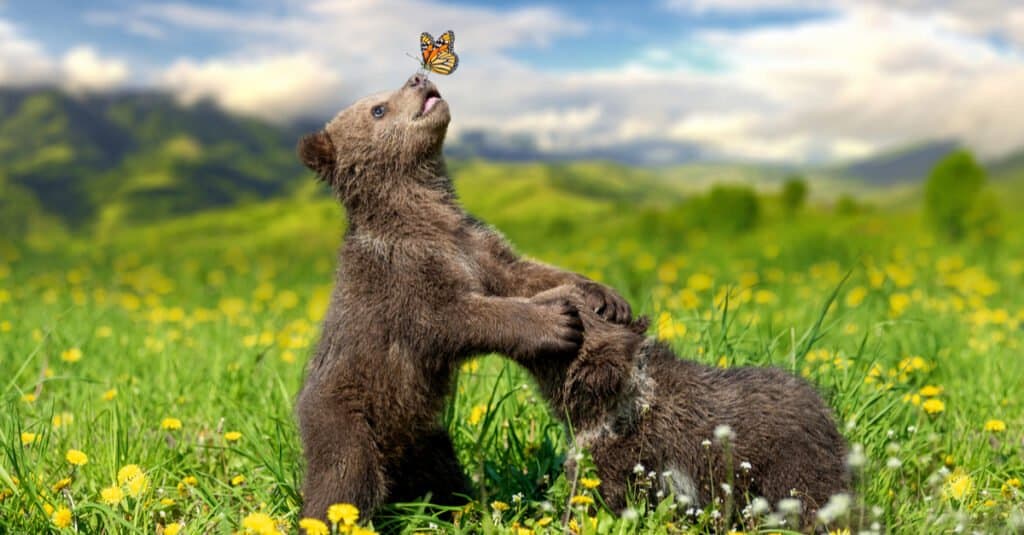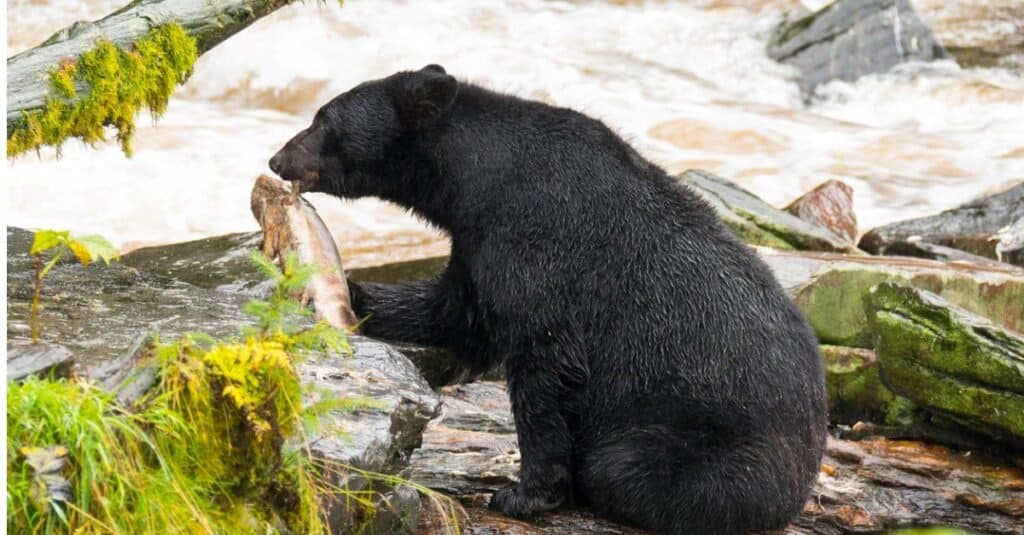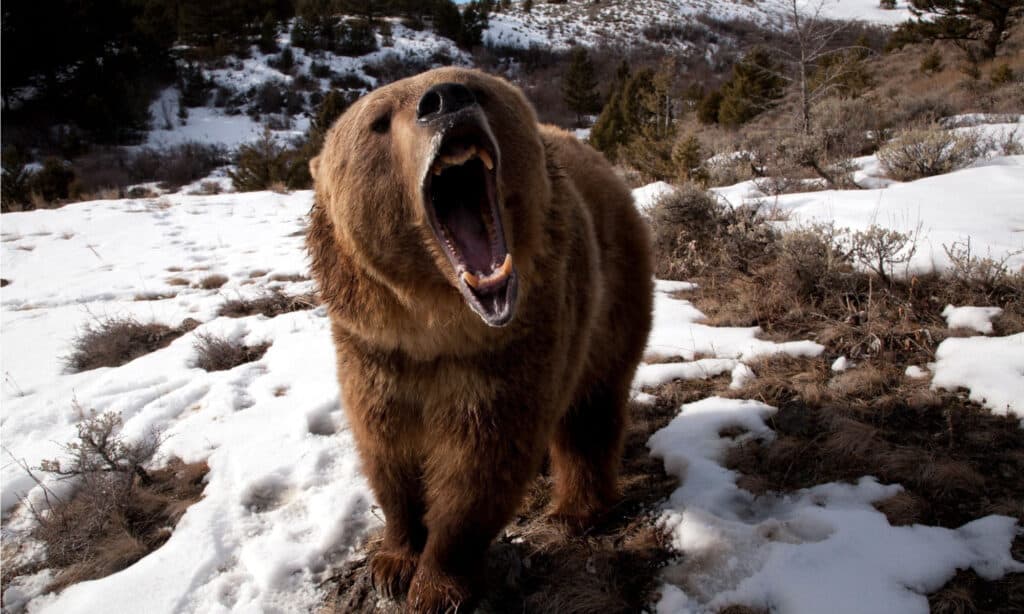Yellowstone National Park has a long and complicated history, particularly when it comes to Yellowstone bear attacks. Just how often did these attacks occur, and is this something that still happens today? Bear safety is a priority in Yellowstone, but is it something that campers are aware of and careful about?
In this article, we will address the complex history of Yellowstone bear attacks, including some of the reasons why they were so prevalent during a portion of the park’s history. In addition, we will go over how often these attacks happen today, where you can safely view bears in Yellowstone, and how to be safe in bear country. Let’s get started!
How Often Do Bear Attacks Happen in Yellowstone?

Yellowstone Park Rangers kept bear cubs as pets, campers allowed bears to sit with them at their picnic tables, and many tourists lured bears into their cars or other places in order to take vintage selfies with them.
©Perpis/Shutterstock.com
Bear attacks happen rarely in Yellowstone nowadays, but this was not always the case. In fact, there was an average of 45 injuries per year from 1930 all the way to the late 1960s. Nowadays, the amount of bear attacks has dwindled to roughly one single injury every 5 years or more, and this trend has been stable since the 1980s.
Why might this be? There are a number of reasons as to why so many bear attacks occurred during this period of time, as well as why very few happen in our modern era. To answer this question, let’s take a closer look at the history of both black bears and grizzly bears in Yellowstone National Park.
Yellowstone National Park’s History with Bears

Nowadays, the amount of bear attacks in Yellowstone has dwindled to roughly one single injury every 5 years or more.
©BGSmith/Shutterstock.com
The history of bears in Yellowstone is as old as the park itself. Established in 1872, Yellowstone National Park became the first ever National Park in the world, whether the black bear or grizzly bear population was aware of it. Given the sudden influx of infrastructure and visitors with very few rules in place, it didn’t take long for the bears to adapt.
What were they adapting to, exactly? Humanity. Humans came to Yellowstone year after year, and both bear species quickly realized where they could get a free meal from. Trash cans, campsites, cars, and popular outdoor areas in Yellowstone become hotbeds for bear activity… Primarily because tourists fed them willingly.

Humans came to Yellowstone year after year, and both bear species quickly realized where they could get a free meal from.
©Volodymyr Burdiak/Shutterstock.com
Yellowstone National Park became famous for this fact. The simple fact that you could visit and have the opportunity to feed a wild and dangerous apex predator. Bears began adapting to humans and human influence, also known as habituation, and the situation quickly grew out of control. By the 1930s, bears approached vehicles to beg for food, knew when the local restaurants threw out kitchen scraps and where the dumps were, and invaded campsites like stray cats.
Yellowstone Park Rangers kept bear cubs as pets, campers allowed bears to sit with them at their picnic tables, and many tourists lured bears into their cars or other places in order to take vintage selfies with them. It was a free-for-all, but not something that was good for humans or bears. Attacks and injuries were commonplace. This was primarily because there were no rules in place from the beginning and the bear population was used to free food, generation after generation.
Controlling Yellowstone Bear Attacks

In the 1980s, the Yellowstone bear population learned how to hunt again and steadily avoided humans.
©iStock.com/ElliotHurwitt
So, what happened? How did the park return to its safe and conscientious state that it’s in today? In the 1970s, after decades of attacks and inappropriate learned behavior by both humans and bears, Yellowstone mandated change. Rangers and park professionals closed anywhere that bears could access food, including dumps, trash cans, and campgrounds. They actively stopped visitors from feeding bears from their cars or while on trails.
It took time for the bear population to catch on, and many feared that grizzlies and black bears would never revert back to wild food sources. Bears who continued to invade campsites or pester tourists in their vehicles were put down or relocated. This caused further issues for Yellowstone from a PR perspective. It was a nightmare, made worse by the simple fact that the bear population didn’t know they were doing anything wrong.
Eventually, however, in the 1980s, the Yellowstone bear population learned how to hunt again and steadily avoided humans. There are still bear interactions to this day, but none as commonplace and bold as the bear interactions from this bygone era!
Where Can I Safely See Bears in Yellowstone?

Bears who continued to invade campsites or pester tourists in their vehicles were put down or relocated, and this caused further issues for Yellowstone from a PR perspective.
©Colton Stiffler/Shutterstock.com
Just because you can’t feed bears from your car anymore doesn’t mean you can’t still see bears in Yellowstone! In fact, both black bears and grizzly bears are commonly sighted in the following locations, best seen at either dawn or dusk:
- Bechler area
- Northern ridge
- Tower area
- Mammoth area
- Fishing Bridge
- Mt. Washburne
- Lamar Valley
- Hayden Valley
- East entrance area
Tips for Exploring Yellowstone’s Bear Country

In the 1970s, after decades of attacks and inappropriate learned behavior by both humans and bears, Yellowstone mandated change.
©Falade Adewale/Shutterstock.com
The primary reason that so many bear attacks occurred in Yellowstone’s history is the fact that tourists didn’t know how to best prepare for being in bear country. Here are some tips for spending time in Yellowstone National Park, whether you plan on hiking, camping, or doing any other activities around bears!:
- Always remain 100 yards or more away from any carnivore in Yellowstone
- Gently honk your horn or drive away if a bear gets too close to your car
- Store all food and potentially smelly supplies in your vehicle, bear boxes, or hung high on a pole or tree branch
- Do not wear heavily scented body products
- When camping, pitch your tent away from where you cook, whenever possible
There are a number of other fantastic tips for staying safe in bear country on Yellowstone’s website. Remember that it isn’t just your safety that you’re considering: it’s for the safety of the bears too!
The photo featured at the top of this post is © NaturesMomentsuk/Shutterstock.com
Thank you for reading! Have some feedback for us? Contact the AZ Animals editorial team.







